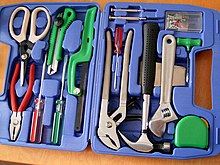ابزار

اَبزار وسیلهای است کاربردی که از آن برای تعمیرات یا تولید محصول استفاده میشود اما در طی فرایند تولید، مصرف نمیشود. بهطور ساده، یک ابزار وسیلهای است برای رسیدن به یک هدف خاص. ابزارهایی که در زمینههای خاصی استفاده شدهاند ممکن است نامهای مختلفی هم داشته باشند از قبیل آلت، ظرف، افزار، دستگاه، اهرم. در تعریف دیگر ابزار شیئی است که میتواند توانایی فرد را برای اصلاح ویژگیهای محیط اطراف یا کمک به انجام یک کار خاص گسترش دهد. اگرچه بسیاری از حیوانات از ابزار ساده استفاده میکنند، اما تنها انسانها از ابزارهایی برای ساخت ابزارهای دیگر استفاده میکنند.[۱][۲][۳]
ابزارهای اولیه بشر که از موادی مانند سنگ، استخوان و چوب ساخته شده بودند، برای تهیه غذا، شکار، ساخت سلاح، تولید پوشاک و مصنوعات مفید و صنایع دستی مانند سفال استفاده میشد.[۴][۵][۶][۷][۸][۹][۱۰]
انقلاب صنعتی نقطه عطف استفاده از ابزارها است. خودکارسازی گسترده در قرنهای ۱۹ و ۲۰ به ابزارها اجازه داد تا با حداقل نظارت انسانی کار کنند و بهرهوری نیروی کار انسانی را افزایش دهند. طرفداران نانوتکنولوژی انتظار دارند که با تبدیل شدن ابزارها به اندازه میکروسکوپی تعداد و تنوع ابزار افزایش مشابه دوران انقلاب صنعتی داشته باشد.[۱۱][۱۲][۱۳][۱۴]

جستارهای وابسته
[ویرایش]منابع
[ویرایش]- ↑ Miller, Terry E. (2001). Sam, Sam-Ang. Oxford Music Online. Oxford University Press. doi:10.1093/gmo/9781561592630.article.49387. Archived from the original on 2022-07-30. Retrieved 2021-01-27.
- ↑ Whiten, David J.; Whiten, Phyllis (April 2009). "Why Are Things Shaped the Way They Are?". Teaching Children Mathematics. 15 (8): 464–472. doi:10.5951/tcm.15.8.0464. ISSN 1073-5836. Archived from the original on 2022-07-30. Retrieved 2021-01-27.
- ↑ Jones, S.; Martin, R.; Pilbeam, D., eds. (1994). The Cambridge Encyclopedia of Human Evolution. Cambridge: Cambridge University Press. ISBN 978-0-521-32370-3. Also شابک ۰−۵۲۱−۴۶۷۸۶−۱ (paperback)
- ↑ McPherron, Shannon P.; Zeresenay Alemseged; Curtis W. Marean; Jonathan G. Wynn; Denne Reed; Denis Geraads; Rene Bobe; Hamdallah A. Bearat (2010). "Evidence for stone-tool-assisted consumption of animal tissues before 3.39 million years ago at Dikika, Ethiopia". Nature. 466 (7308): 857–60. Bibcode:2010Natur.466..857M. doi:10.1038/nature09248. PMID 20703305. S2CID 4356816.
- ↑ Sahnouni, Mohamed; Semaw, Sileshi; Rogers, Michael (2013-07-04). "The African Acheulean". Oxford Handbooks Online. doi:10.1093/oxfordhb/9780199569885.013.0022. Archived from the original on 2022-07-30. Retrieved 2021-01-27.
- ↑ "Rethinking Concepts and Theories". Gendered Innovations. Retrieved 19 January 2023.
- ↑ Holmes, Bob. "Man's early hunting role in doubt". Newscientist.com. Archived from the original on 12 June 2015. Retrieved 12 November 2012.
- ↑ Hollister-Short, Graham; James, Frank (2016). History of Technology Volume 12. London: Bloomsbury Publishing. ISBN 978-1-350-01858-7. OCLC 957126707. Archived from the original on 2022-08-29. Retrieved 2022-08-29.
- ↑ Selin, Helaine, ed. (2008). Encyclopaedia of the history of science, technology, and medicine in non-western cultures (2nd ed.). Berlin: Springer. ISBN 978-1-4020-4425-0. OCLC 261324840. Archived from the original on 2022-08-29. Retrieved 2022-08-29.
- ↑ Headrick, Daniel R. (2009). Technology: a world history. Oxford: Oxford University Press. ISBN 978-0-19-971366-0. OCLC 320625444. Archived from the original on 2022-08-29. Retrieved 2022-08-29.
- ↑ Whelan, David (2012-10-25). "Nanotechnology: Big Potential In Tiny Particles - Forbes.com". Forbes. Archived from the original on 2012-10-25. Retrieved 2021-01-27.
- ↑ Arabe, Katrina C. "Will this Tiny Science Usher in the Next Industrial Revolution?". www.thomasnet.com. Archived from the original on 2021-02-24. Retrieved 2021-01-27.
- ↑ «روشهای نانوساخت به کمک توسعه ابزارهای زیستالکترونیک آمد». پایگاه خبری فناوری نانو ایران. ۲۰۲۳-۰۷-۱۹.
- ↑ «آشنایی شرکتهای فناور با ابزارهای تحلیل بازار در نمایشگاه نانو». خبرگزاری مهر | اخبار ایران و جهان. ۲۰۲۳-۰۹-۰۴.
- ↑ مروری بر کشف ابزار اولیه تا ساخت ابزار مدرن. «جعبه ابزار پلاستیکی». دریافتشده در ۲۰۲۳-۱۲-۲۳.
